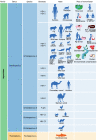Viral hepatitis: Milestones, unresolved issues, and future goals
- PMID: 34366625
- PMCID: PMC8326259
- DOI: 10.3748/wjg.v27.i28.4603
Viral hepatitis: Milestones, unresolved issues, and future goals
Abstract
In this review the current overall knowledge on hepatitis A, B, C, D, and E will be discussed. These diseases are all characterized by liver inflammation but have significant differences in distribution, transmission routes, and outcomes. Hepatitis B virus and hepatitis C virus are transmitted by exposure to infected blood, and in addition to acute infection, they can cause chronic hepatitis, which in turn can evolve into cirrhosis. It is estimated that more than 300 million people suffer from chronic hepatitis B or C worldwide. Hepatitis D virus, which is also transmitted by blood, only affects hepatitis B virus infected people, and this dual infection results in worse liver-related outcomes. Hepatitis A and E spread via the fecal-oral route, which corresponds mainly to the ingestion of food or water contaminated with infected stools. However, in developed countries hepatitis E is predominantly a zoonosis. Although hepatitis A virus and hepatitis E virus are usually responsible for a self-limiting hepatitis, a serious, rarely fatal illness is also possible, and in immunosuppressed patients, such as organ transplant recipients, hepatitis E virus infection can become chronic. The description of goals achieved, unresolved issues, and the latest research on this topic may make it possible to speculate on future scenarios in the world of viral hepatitis.
Keywords: Hepatitis A; Hepatitis B; Hepatitis C; Hepatitis D; Hepatitis E; Viral hepatitis.
©The Author(s) 2021. Published by Baishideng Publishing Group Inc. All rights reserved.
Conflict of interest statement
Conflict-of-interest statement: Authors declare no conflict of interests for this article.
Figures



References
-
- Choo QL, Kuo G, Weiner AJ, Overby LR, Bradley DW, Houghton M. Isolation of a cDNA clone derived from a blood-borne non-A, non-B viral hepatitis genome. Science . 1989;244:359–362. - PubMed
-
- Kuo G, Choo QL, Alter HJ, Gitnick GL, Redeker AG, Purcell RH, Miyamura T, Dienstag JL, Alter MJ, Stevens CE. An assay for circulating antibodies to a major etiologic virus of human non-A, non-B hepatitis. Science . 1989;244:362–364. - PubMed
-
- Kolykhalov AA, Agapov EV, Blight KJ, Mihalik K, Feinstone SM, Rice CM. Transmission of hepatitis C by intrahepatic inoculation with transcribed RNA. Science . 1997;277:570–574. - PubMed
-
- Borgia SM, Hedskog C, Parhy B, Hyland RH, Stamm LM, Brainard DM, Subramanian MG, McHutchison JG, Mo H, Svarovskaia E, Shafran SD. Identification of a Novel Hepatitis C Virus Genotype From Punjab, India: Expanding Classification of Hepatitis C Virus Into 8 Genotypes. J Infect Dis . 2018;218:1722–1729. - PubMed
Publication types
MeSH terms
LinkOut - more resources
Full Text Sources

